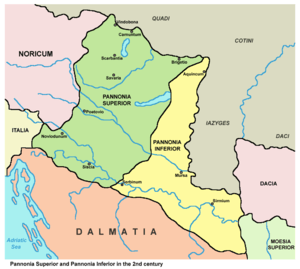Pannonia Superior
| Provincia Pannonia Superior | |||||
| Province of the Roman Empire | |||||
| |||||
 | |||||
| Capital | Carnuntum | ||||
| History | |||||
| • | Established | 103 | |||
| • | Disestablished | 3rd century | |||
| Today part of | | ||||
Pannonia Superior, lit. Upper Pannonia, was an ancient Roman province with the capital in Carnuntum. It was formed in the year 103 AD. The province included parts of present-day Hungary, Austria, Croatia, Slovenia, Bosnia and Herzegovina, and Slovakia.
History
It was as governor of the province that Septimius Severus made his bid for the Roman Imperial throne in April 193 CE.
In 308 the Emperor Diocletian chaired a historic meeting with his co-emperors Maximian and Galerius in Carnuntum to solve the rising tensions within the tetrarchy
Cities
Some of the important cities in Upper Pannonia were:
- Siscia (today Sisak)
- Poetovio (today Ptuj)
- Iovia Botivo (today Ludbreg)
- Aquae Balissae (today Daruvar)
- Servitium/Serbinum (today Gradiška)
- Andautonia (today Ščitarjevo)
- Savaria (today Szombathely)
- Scarbantia (today Sopron)
- Arrabona (today Győr)
- Vindobona (today Vienna)
Later usage
The northern part of the 8th-century Frankish March of Pannonia was also called Upper Pannonia. The name can be found even much later in a similar, but wider, meaning. E.g. Otto von Freising (Chron. 6, 15) uses it to refer to Austria (i.e. Austria proper) in the 12th century.
